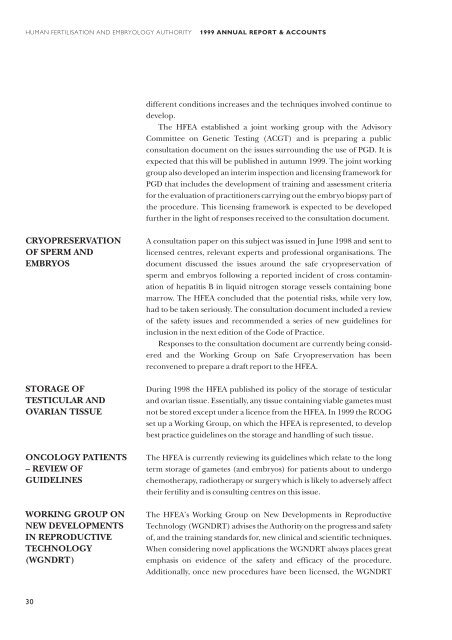HEFA-1999 Part 1/2nd proof - Human Fertilisation & Embryology ...
HEFA-1999 Part 1/2nd proof - Human Fertilisation & Embryology ...
HEFA-1999 Part 1/2nd proof - Human Fertilisation & Embryology ...
You also want an ePaper? Increase the reach of your titles
YUMPU automatically turns print PDFs into web optimized ePapers that Google loves.
HUMAN FERTILISATION AND EMBRYOLOGY AUTHORITY<br />
<strong>1999</strong> ANNUAL REPORT & ACCOUNTS<br />
different conditions increases and the techniques involved continue to<br />
develop.<br />
The HFEA established a joint working group with the Advisory<br />
Committee on Genetic Testing (ACGT) and is preparing a public<br />
consultation document on the issues surrounding the use of PGD. It is<br />
expected that this will be published in autumn <strong>1999</strong>. The joint working<br />
group also developed an interim inspection and licensing framework for<br />
PGD that includes the development of training and assessment criteria<br />
for the evaluation of practitioners carrying out the embryo biopsy part of<br />
the procedure. This licensing framework is expected to be developed<br />
further in the light of responses received to the consultation document.<br />
CRYOPRESERVATION<br />
OF SPERM AND<br />
EMBRYOS<br />
STORAGE OF<br />
TESTICULAR AND<br />
OVARIAN TISSUE<br />
ONCOLOGY PATIENTS<br />
– REVIEW OF<br />
GUIDELINES<br />
WORKING GROUP ON<br />
NEW DEVELOPMENTS<br />
IN REPRODUCTIVE<br />
TECHNOLOGY<br />
(WGNDRT)<br />
A consultation paper on this subject was issued in June 1998 and sent to<br />
licensed centres, relevant experts and professional organisations. The<br />
document discussed the issues around the safe cryopreservation of<br />
sperm and embryos following a reported incident of cross contamination<br />
of hepatitis B in liquid nitrogen storage vessels containing bone<br />
marrow. The HFEA concluded that the potential risks, while very low,<br />
had to be taken seriously. The consultation document included a review<br />
of the safety issues and recommended a series of new guidelines for<br />
inclusion in the next edition of the Code of Practice.<br />
Responses to the consultation document are currently being considered<br />
and the Working Group on Safe Cryopreservation has been<br />
reconvened to prepare a draft report to the HFEA.<br />
During 1998 the HFEA published its policy of the storage of testicular<br />
and ovarian tissue. Essentially, any tissue containing viable gametes must<br />
not be stored except under a licence from the HFEA. In <strong>1999</strong> the RCOG<br />
set up a Working Group, on which the HFEA is represented, to develop<br />
best practice guidelines on the storage and handling of such tissue.<br />
The HFEA is currently reviewing its guidelines which relate to the long<br />
term storage of gametes (and embryos) for patients about to undergo<br />
chemotherapy, radiotherapy or surgery which is likely to adversely affect<br />
their fertility and is consulting centres on this issue.<br />
The HFEA’s Working Group on New Developments in Reproductive<br />
Technology (WGNDRT) advises the Authority on the progress and safety<br />
of, and the training standards for, new clinical and scientific techniques.<br />
When considering novel applications the WGNDRT always places great<br />
emphasis on evidence of the safety and efficacy of the procedure.<br />
Additionally, once new procedures have been licensed, the WGNDRT<br />
30

















